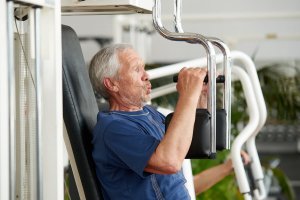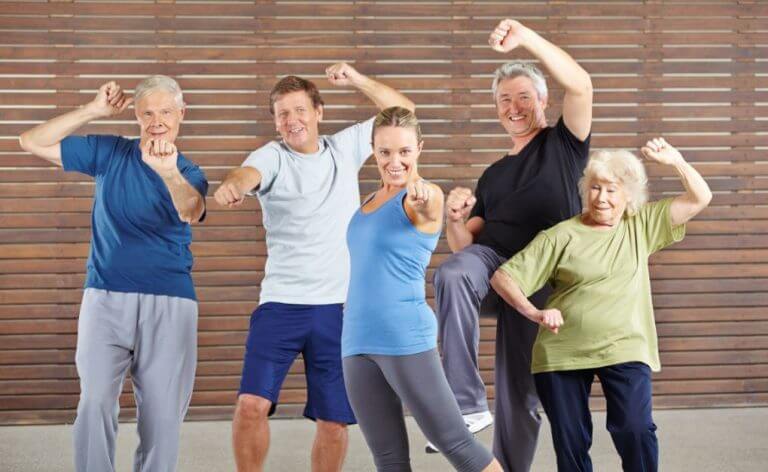The Relationship Between Strength Training and Aging

Strength training has a lot of benefits to our health and quality of life. Getting started with this type of sport from an early age can ensure we have good muscle, bone, and even psychological health. On top of that, it also has benefits for our respiratory and cardiovascular systems. For all of these reasons, strength training and aging are two concepts with a very close relationship.
Aging is an inevitable process because no one can escape the passage of time. However, as you’ll see in this article, strength training is a great way to fight the effects of aging and slow them down as much as possible.
Strength training and aging
Strength training consists of conquering an external load or our own body weight through the contraction of the muscles. It’s the type of sport that requires greater muscle development, in comparison to others that mostly focus on cardiovascular improvement.
While we usually think about strength training as workouts we do at the gym to tone and increase our muscle mass, there are several sport disciplines that we can consider strength training as well:
- Javelin or hammer throw
- Contact sports
- Weightlifting
- CrossFit
- Powerlifting
Aging
As we said before, aging is a physiological and natural process. It happens due to the effect of the passage of time on our body cells. After puberty is complete, and we stop growing, our cells cease to replicate and regenerate.
For this reason, they start to accumulate injuries and wear throughout our life. The damage then manifests as aging on a macroscopic level.

It’s an irreversible process, but we can slow down its appearance and progression. A good lifestyle combined with eating a healthy diet, getting enough rest and avoiding bad habits such as the use of drugs -alcohol and smoking included- will greatly help to reduce the process of aging.
Sports in general, and strength training specifically, are a very efficient method to fight against the most limiting symptoms of aging. Let’s look at what they are in the next paragraphs.
Sarcopenia
Sarcopenia is one of the most limiting processes of aging in the long run. It consists of a loss of muscle mass and strength as aging progresses, and it’s irreversible.
This condition is related to microscopic injuries in the muscle structure and the loss of anabolic hormones such as testosterone and the growth hormone. The levels of both of these hormones decrease as we become older.
Strength training not only helps to considerably delay the appearance of sarcopenia but it’s also able to reduce it greatly when it starts to manifest.
This physical exercise stimulates the hormones we mentioned previously and helps to keep their levels elevated for a longer period of time. On top of that, the mere act of exercising helps to create and maintain muscle mass, and all of this contributes to the maintenance of strength and functionality.
Loss of bone density
The loss of bone density is something that happens physiologically with age. The bones become progressively more brittle and fragile, and this leads to the risk of fractures and fissures.
All of this is accelerated by osteoporosis, which begins attacking women after menopause. This condition can also affect men, but it’s less frequent, especially after they reach their 60s.

Strength training requires a lot of stability from our bones and joints. The anabolic hormones we mentioned earlier also play a role in maintaining healthy levels of bone density. Generally, this type of training will improve the bone structure and slow down its wear.
The benefits of strength training in the fight against aging
Maintaining good levels of muscle mass and bone density allows us to preserve our functionality and independence. On top of reducing the risk of injuries or fractures that are common in older people, it also allows us to have an active lifestyle.
Doing cardio exercises will also reduce the occurrence of heart and respiratory diseases. If we combine all of these benefits, our life expectancy, but most importantly our life quality, will improve.
In conclusion, it’s worth remembering an important saying in modern medicine that claims that exercise is the best medicine. Working out in general, but especially with strength training, is a great ally in the fight against aging.
Strength training has a lot of benefits to our health and quality of life. Getting started with this type of sport from an early age can ensure we have good muscle, bone, and even psychological health. On top of that, it also has benefits for our respiratory and cardiovascular systems. For all of these reasons, strength training and aging are two concepts with a very close relationship.
Aging is an inevitable process because no one can escape the passage of time. However, as you’ll see in this article, strength training is a great way to fight the effects of aging and slow them down as much as possible.
Strength training and aging
Strength training consists of conquering an external load or our own body weight through the contraction of the muscles. It’s the type of sport that requires greater muscle development, in comparison to others that mostly focus on cardiovascular improvement.
While we usually think about strength training as workouts we do at the gym to tone and increase our muscle mass, there are several sport disciplines that we can consider strength training as well:
- Javelin or hammer throw
- Contact sports
- Weightlifting
- CrossFit
- Powerlifting
Aging
As we said before, aging is a physiological and natural process. It happens due to the effect of the passage of time on our body cells. After puberty is complete, and we stop growing, our cells cease to replicate and regenerate.
For this reason, they start to accumulate injuries and wear throughout our life. The damage then manifests as aging on a macroscopic level.

It’s an irreversible process, but we can slow down its appearance and progression. A good lifestyle combined with eating a healthy diet, getting enough rest and avoiding bad habits such as the use of drugs -alcohol and smoking included- will greatly help to reduce the process of aging.
Sports in general, and strength training specifically, are a very efficient method to fight against the most limiting symptoms of aging. Let’s look at what they are in the next paragraphs.
Sarcopenia
Sarcopenia is one of the most limiting processes of aging in the long run. It consists of a loss of muscle mass and strength as aging progresses, and it’s irreversible.
This condition is related to microscopic injuries in the muscle structure and the loss of anabolic hormones such as testosterone and the growth hormone. The levels of both of these hormones decrease as we become older.
Strength training not only helps to considerably delay the appearance of sarcopenia but it’s also able to reduce it greatly when it starts to manifest.
This physical exercise stimulates the hormones we mentioned previously and helps to keep their levels elevated for a longer period of time. On top of that, the mere act of exercising helps to create and maintain muscle mass, and all of this contributes to the maintenance of strength and functionality.
Loss of bone density
The loss of bone density is something that happens physiologically with age. The bones become progressively more brittle and fragile, and this leads to the risk of fractures and fissures.
All of this is accelerated by osteoporosis, which begins attacking women after menopause. This condition can also affect men, but it’s less frequent, especially after they reach their 60s.

Strength training requires a lot of stability from our bones and joints. The anabolic hormones we mentioned earlier also play a role in maintaining healthy levels of bone density. Generally, this type of training will improve the bone structure and slow down its wear.
The benefits of strength training in the fight against aging
Maintaining good levels of muscle mass and bone density allows us to preserve our functionality and independence. On top of reducing the risk of injuries or fractures that are common in older people, it also allows us to have an active lifestyle.
Doing cardio exercises will also reduce the occurrence of heart and respiratory diseases. If we combine all of these benefits, our life expectancy, but most importantly our life quality, will improve.
In conclusion, it’s worth remembering an important saying in modern medicine that claims that exercise is the best medicine. Working out in general, but especially with strength training, is a great ally in the fight against aging.
All cited sources were thoroughly reviewed by our team to ensure their quality, reliability, currency, and validity. The bibliography of this article was considered reliable and of academic or scientific accuracy.
- Copeland, J. L., Good, J., & Dogra, S. (2019). Strength training is associated with better functional fitness and perceived healthy aging among physically active older adults: a cross-sectional analysis of the Canadian Longitudinal Study on Aging. Aging Clinical and Experimental Research, 31(9), 1257–1263. https://doi.org/10.1007/s40520-018-1079-6
- Papa, E. V, Dong, X., & Hassan, M. (2017). Resistance training for activity limitations in older adults with skeletal muscle function deficits: a systematic review. Clinical Interventions in Aging, 12, 955–961. https://doi.org/10.2147/CIA.S104674
- Lambert, C. P., & Evans, W. J. (2002). Effects of aging and resistance exercise on determinants of muscle strength. Journal of the American Aging Association, 25(2), 73–78. https://doi.org/10.1007/s11357-002-0005-0
- Mayer, F., Scharhag-Rosenberger, F., Carlsohn, A., Cassel, M., Müller, S., & Scharhag, J. (2011). The intensity and effects of strength training in the elderly. Deutsches Arzteblatt International, 108(21), 359–364. https://doi.org/10.3238/arztebl.2011.0359
This text is provided for informational purposes only and does not replace consultation with a professional. If in doubt, consult your specialist.








